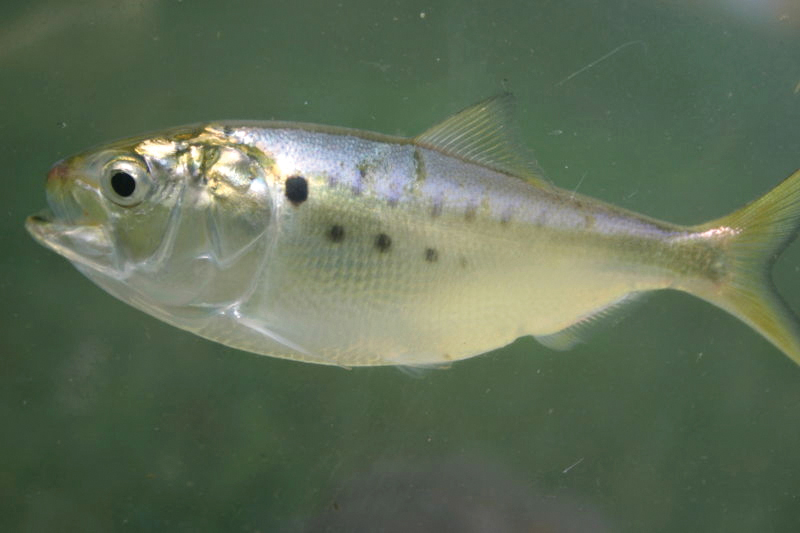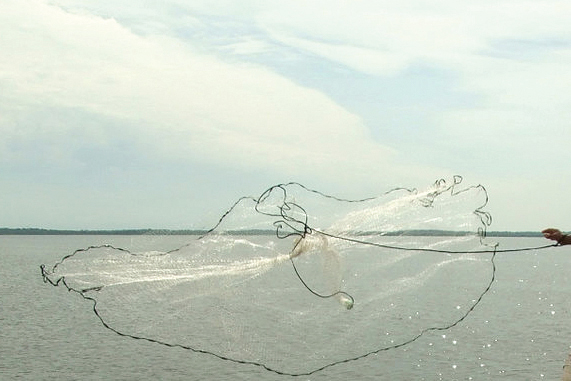Fall is when the main-stem Bay comes alive with fish, as hordes of peanut bunker—young of the year—migrate out of countless coves and creeks, into tributaries, and then out into open water. The rockfish know darn well that they’re coming. Stripers will be staging at the mouths of tributaries from the northernmost reaches of the Chesapeake clear down to the mouth of the Bay, waiting for this mass migration. They will be doing so in order to fatten up for the winter, and this means a live, wiggling peanut bunker on the end of your line becomes the ultimate bait.

Catch as Catch Can
The hardest part of live-lining with peanuts at this time of year is, quite simply, obtaining a bait supply. These fish are four to five inches long, so they’re too small to effectively gather with a bunker-snagger. Bait shops don’t carry them, and you could try to get one on a hook and line for the rest of your life without success. That leaves only one effective method of gathering these fish: cast netting.
The net you use will have a huge impact on how successful you are. A six-footer is a bare minimum, and won’t work well in depths over six or eight feet of water because the bunker will swim out from under it. Very small mesh, like three-sixteenths or one-quarter-inch, doesn’t work well for the same reason (the smaller the mesh, the slower the net sinks). The state of Maryland limits you to a 10-foot radius net so in Maryland waters, that makes a 10-footer optimal. Otherwise, generally speaking, bigger is better. (Note: a 10-footer with half-inch mesh will work well in water down to 12- or 15-feet deep and sometimes you’ll get lucky in water up to 20-feet).
Two tactics are effective when choosing where to throw your net. The first and best way to do it is to hit the water just before dawn, and look for piers or bridges with artificial light—the brighter the better. Bunker will swarm around lights before the sun comes up, and one good cast on a well-lighted pier is all it takes to fill the livewell sometimes. TIP: Before throwing the net, toss a black or dark purple jig or topwater lure into the lighted water two or three times. Often, stripers are right there with the bunker trying to pick off an easy breakfast.

The second effective tactic is to place the net-thrower on the bow of the boat, and idle along slowly looking for flipping bunker. This method is less reliable and sometimes you get lucky, but other times it’ll take a dozen throws or more before your net lands open over a good school. When you do get lucky, a word of warning: it’s possible to haul in dozens of peanut bunker at a time, which isn’t necessarily a good thing. Bunker need about a gallon of water per fish in the livewell, so it’s very easy to keep too many and over-crowd the well. Be sure to release any extras ASAP, to avoid overkill.
Rigged and Ready
With your bunker tucked away in the livewell, it’s time to rig up. Either spinning or conventional gear in the 12- to 20-pound range will work well, but reels should be spooled with monofilament as opposed to braid. Mono is always best for fishing livies, because the no-stretch, high-sensitivity characteristics of braid can tip the stripers off and they’ll know something’s amiss the moment they grab the bait.
Leaders should be about four feet of 20- to 30-pound monofilament, with a thin wire live bait hook tied on the end. These baby bunker are much more delicate than the spot we usually live-line with, and using a thin hook is important to minimize the damage down when you thread one on the hook, and the amount of weight the fish has to carry once it’s in the water.
How much weight you’ll want to use varies depending on where the stripers are in the water column and the depth of the water you’re fishing. Another difference between spot and bunker is that this species will often try to stay near the surface, and if the fish are down five feet or more, additional weight is usually necessary. A good way to add it is with a rubber-core sinker, which can be added, removed, or swapped out for differing sizes in a heart-beat. These fish are small and unable to fight the weight, so it usually doesn’t take much; a quarter or half an ounce is usually plenty unless you’re fighting a stiff wind and/or current.
Bunker can be hooked through the back, just behind the dorsal (which will encourage them to swim down a bit) or in through the mouth and out through the upper jaw. Going through the nose doesn’t work well as they’ll often turn the hook and bury it back in their own body, and pinning their mouth closed by going through both jaws will reduce their ability to breath and quickly kill them.

On the Hook
Okay: you have your bunker, you’re all rigged up, and it’s time to fish. What next? Locating the best spot to soak them is obviously important, so keep up to date with our fishing reports at FishTalkMag.com. That said, at this time of year the stripers will often be located where that bunker’s friends can be found. Expect to find them in open water near channel edges and sharp drop-offs. Any time you see bunker flipping in open water and see fish on the meter, you’re in a good position. And stripers holding on structure will chew on these little bunker like there’s no tomorrow. In most cases, unless you’re fishing tight to structure, drifting the bunker is usually more effective than anchoring your boat.
When you get a take, it’s best to let the striper eat for about three seconds before setting the hook (or coming tight on a circle hook). Yes, it would be even more effective to give the fish a five-count. But using these small bunker you’ll catch plenty of throw-back stripers, and if you allow them to eat for too long, you’ll end up gut-hooking undersized fish—something none of us want.
Is throwing a cast net to catch the bunker a pain in the butt? You bet. Is this form of fishing messier than casting jigs? Absolutely. Will you hate getting your hands wet as you bait up in the chilly November air? Youbetcha. But set all of these impediments aside, because as those striped bass fatten up for winter their sights are set on swallowing peanuts—and placing one on your hook is a tough tactic to beat.
by Lenny Rudow